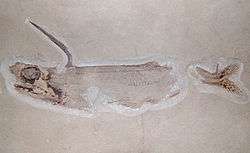Falcatus
| Falcatus Temporal range: 335–318 Ma Middle Viséan - Late Serpukhovian | |
|---|---|
 | |
| Specimen in Vienna | |
| Scientific classification | |
| Kingdom: | Animalia |
| Phylum: | Chordata |
| Class: | Chondrichthyes |
| Subclass: | Elasmobranchii |
| Order: | Symmoriida |
| Family: | Falcatidae |
| Genus: | Falcatus Lund, 1985 |
| Species | |
| |
Falcatus is an extinct genus of Falcatidae which lived during the early Carboniferous Period in Bear Gulch bay and what is now Montana.
Description

It was a 25–30 cm or 10-12 inches long "cladodont-toothed stethacanthid shark" [1] The first material known from the genus were the prominent fin spines that curved anteriorly over the head of the animal. When first described in 1883 from the St. Louis Limestone, these remains were given the name Physonemus falcatus. However, in 1985, fossils of a new type of condrichthyan from Montana were described that displayed a high degree of sexual dimorphism. The same spines that were previously named P. falcatus were found on one of the morphs, identified as the male due to the presence of valvae.
In popular culture
Falcatus was featured briefly in an episode of Paleoworld called "Prehistoric Sharks". Falcatus was also shown in two Shark Week specials, one also labelled as "Prehistoric Sharks" (where both were shown in restored form by Paleoartist Ray Troll) and the other known as "Jurassic Shark" where it was labelled as a unicorn shark.[2][3]
References
- David Norman. (2001): The Big Book Of Dinosaurs. Pg.84 and Pg.286, Walcome books.
- ↑ http://www.sju.edu/research/bear_gulch/pages_fish_species/Falcatus_falcatus.php Fossil Fish of Bear Gulch 2005 by Richard Lund and Eileen Grogan Accessed 2009-01-14
- ↑ Prehistoric Sharks
- ↑ Jurassic Shark
- ↑ The morphology of Falcatus falcatus (St. John and Worthen), a Mississippian stethacanthid chondrichthyan from the Bear Gulch Limestone of Montana. Journal of Vertebrate Paleontology 5(1):1-19.
External links
- http://www.elasmo-research.org/education/evolution/golden_age.htm
- http://comenius.susqu.edu/biol/202/Animals/DEUTEROSTOMES/CRANIATA/CHONDRICHTHYES.htm